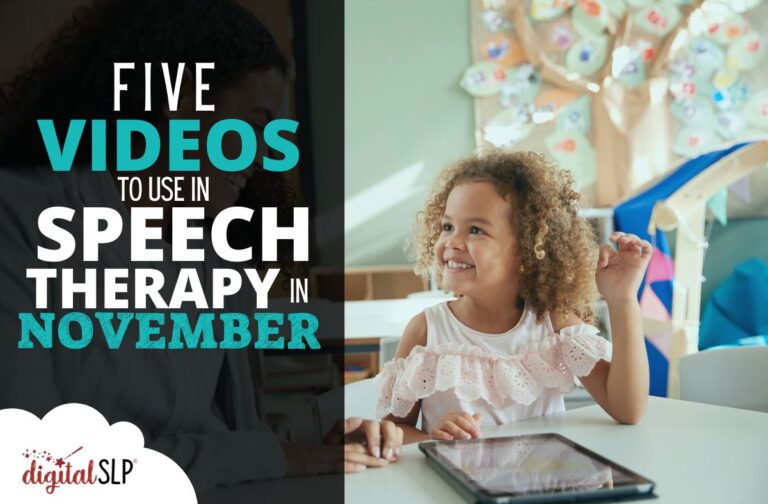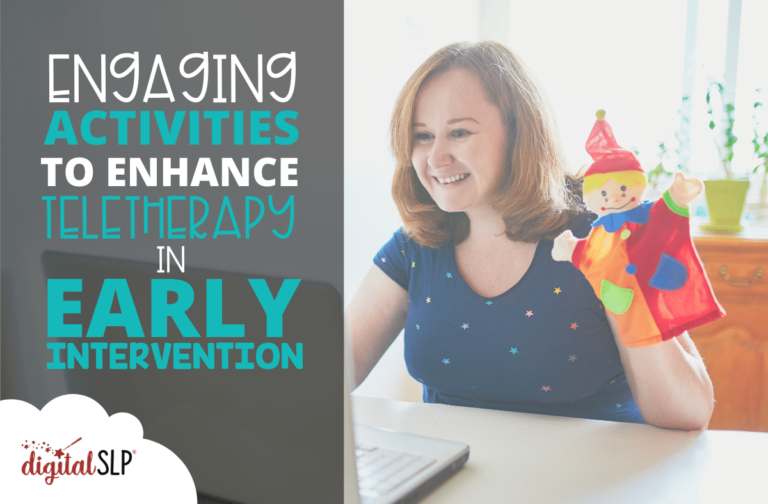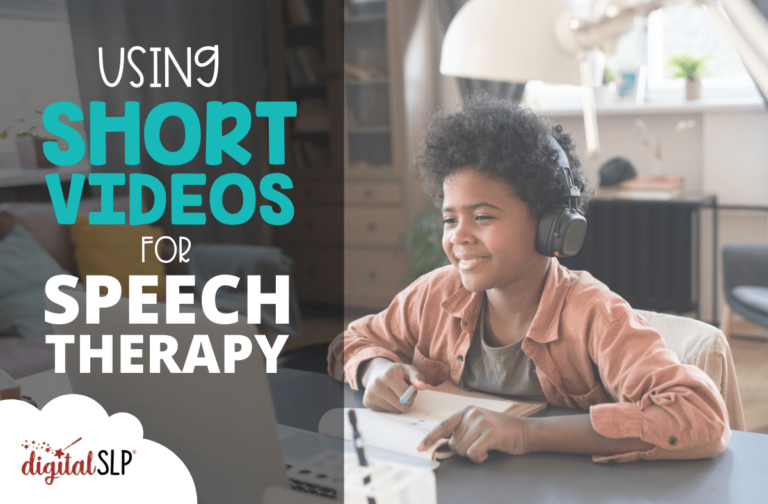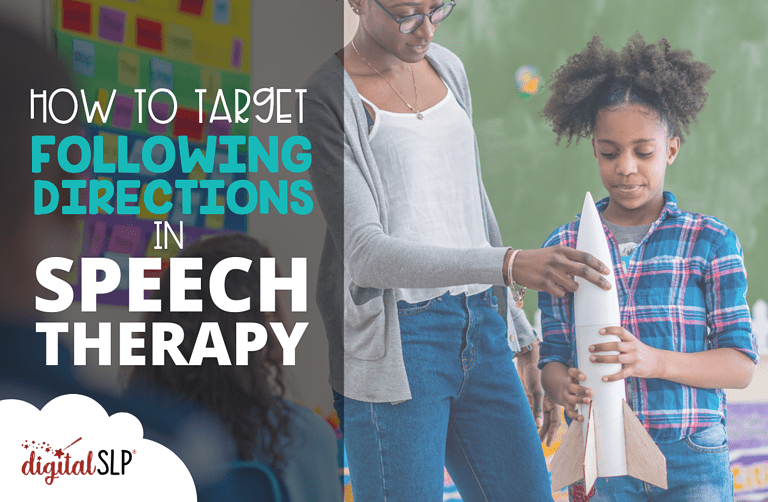Whether you’re feeling grateful or grouchy (or somewhere in between) this November, I hope these video recommendations simplify your planning and enrich your speech therapy sessions.
As always, a quick reminder: I watched all of the videos and found them to be worthwhile, but everyone’s needs are different, so please preview any video fully before sharing it with students.
Length: 4 minutes
Ages: 1st–6th grade
It’s Manatee Awareness Month, and your animal-loving students will be enchanted by this video about these gentle sea creatures.
As they learn fascinating manatee facts, students can also work on many speech and language targets, including:
- Activating prior knowledge: Before starting the video, you could ask students what they know about manatees, and spur further discussion by completing a KWL chart together.
- Adjectives: Because manatees are so unique, they provide the perfect opportunity to dive into descriptors. You could ask students to generate synonyms for the adjectives in this video (e.g., “warm,” “heavy,” “flexible,” “adorable”), or have them consider additional adjectives that describe manatees.
- Compare and contrast: As this video explains, manatees are closely related to elephants! Students could identify similarities and differences between the two species.
- Multiple-meaning words: If students don’t notice it on their own, you could point out video host Jessi’s shirt. It features a picture of a manatee in a teacup, providing a fun opportunity to talk about puns and homophones!
- Extension: Manatees face many threats, including strikes from boats, declining habitats and food supplies, and toxic algae growth. Students could learn about conservation efforts and even watch manatee webcams!
Length: 9 minutes
Ages: Kindergarten–8th grade (very young students may need support)
Host a hands-on celebration of National Origami Day on November 11th with this fun video from the popular channel Art for Kids Hub. It provides detailed, doable instructions for creating a lively little jumping frog.
While folding their new friends, students can work on plenty of speech and language goals, including:
- Basic concepts: As students follow along with the video, they’ll get lots of real-life practice with colors, shapes, prepositions, and more.
- Fluency: Students could select strategies to focus on while folding their frogs, allowing them to practice in a context that has low stakes but is still meaningful.
- Following directions and sequencing: These frogs are cute and complex, so students can use them to practice working with challenging multi-step directions. The video is also long enough that you could split it over several sessions, inviting students to recap the previous session’s steps before moving onto the new segment.
- Narrative: After finishing their frogs, students could create stories about them!
- Extension: Students could learn about the history of origami, or make additional origami animals (the Internet is full of tutorials!).
Length: 5 minutes
Ages: Preschool–2nd grade
November 10th is Sesame Street Day, November 13th is World Kindness Day, and this video is the perfect way to mark both occasions! In it, Elmo learns the definition of kindness, shares some real-life kindness examples, and, of course, closes with a catchy song.
Here are some possible speech and language skills to address with this video:
- Asking questions: Early in the video, Elmo mentions that he has been wondering about kindness. Students could share topics that they’re wondering about and generate questions about those topics.
- Discussion: Students could talk about whether or not they believe kindness is important. They could also discuss their favorite ways to be kind!
- Facial expressions/feelings: Pause at the 0:30 mark and encourage students to identify the character’s emotion(s) using facial expressions as clues.
- Personal narrative: Students could share about a time when someone was kind to them.
- Extension: Students could brainstorm ideas for how to spread kindness—the Random Acts of Kindness Foundation has lots of ideas!
Length: 6 minutes
Ages: 1st–5th grade
This read-aloud of Traci Sorell’s vivid picture book is a beautiful way to honor Native American Heritage Month. It tells the story of River, who experiences an unexpected sense of healing and connection at a tribal powwow.
Powwow Day brings a vibrant Native tradition to life and offers opportunities to engage with several speech and language skills, including:
- Articulation: Students working on /dʒ/ could practice their sound with words like “jingle,” “join,” “judges,” “arrange,” and “language.”
- Cause and effect: The book’s simple plot highlights multiple examples of causal relationships. Students could discuss what they notice, and even brainstorm logical alternate outcomes!
- Inferences: Powwow Day’s main character River is unable to dance at the powwow due to an unnamed illness, but the book does offer some clues about what might be going on. Students could use these clues to make inferences about River’s health.
- Verbs: There are a variety of powerful verbs in Powwow Day, including “savor,” “prickle,” “squeeze,” “guide,” and “surround.” Students could act them out, identify synonyms, or use them to write sentences.
- Extension: Students who are intrigued by the dance featured in the book could learn some of the steps or read about its history.
Length: 8 minutes
Ages: 6th–12th grade
In this TEDx talk, self-assured teen Emmy Grace Cribbs makes the case for why listening is so important, and she shares practical tips for how to enhance our skills. It’s an ideal choice for the National Day of Listening on November 29th.
In addition to improving their listening skills, students can use this video to work on other communication goals, including:
- Describing: Students could share how they can tell when someone is truly listening to them.
- Neurodiversity-affirming pragmatics and social communication: This talk emphasizes traditional listening behaviors like eye contact, which may be uncomfortable for some neurodivergent individuals. Students could brainstorm additional listening behaviors that don’t require eye contact.
- Tier II vocabulary: As students watch the video, they could note Tier II vocabulary words like “prevalence,” “misconception,” “equation,” “strive,” and “deny,” and use context clues to determine their meanings.
- Summarizing: Cribbs packs a lot of information into this 8-minute talk, providing a great opportunity for students to work on their summarizing skills.
- Extension: Students could create and deliver their own TED-style talks on topics of their choosing!
I hope you enjoy these recommendations, and I’m looking forward to sharing a new set with you next month!
If you love using videos in your speech sessions and want weekly recommendations and activity suggestions in your inbox, consider signing up for a Digital SLP membership! This is just one of the many bonuses you receive when you become a paid subscriber.
Click here to learn more.













Recent Comments